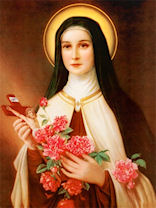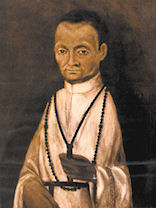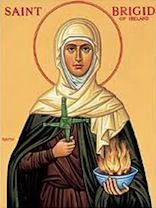Our Saints
What is a Saint?
A saint is a person just like you and me that God gave special graces to in order for them to do special things. All the saints were holy men and women. Some of the saints could work miracles, some could heal, some had the ability to be in two places at once. God knew these people, as He knows us, and gave them these abilities because God knew these people would do His Will. How often do we pray to do God's Will? The saints asked all the time.
How do we make a Saint?
The process used by the church to name a saint is called canonization. This process has been used since the 10th century.
The bishop waits for a long time after the death of a person. Then an investigation is started. His or her life is looked at and any books or papers that are found are read by the bishop to be sure that person follows the true teaching of the church.
Then a group of people called Theologians and cardinals in a group called 'Congregation for the Causes of Saints' at the Vatican look into it and they decide if they should be approved.
If they are approved then the pope makes them Venerable. The next step is after death they have to perform a miracle. That make sure that the person is in heaven. A person like you or me has to ask them for a special thing such as a healing. If we are healed, then the pope can Beatify them. The third and final step is one more miracle. After that miracle then the pope can canonize them. That tells us that the person has led a holy life, is in heaven, and is to be honoured by the Church.
Do we worship the Saints?
No, we don't. We only worship God. The saints only assist us in our prayers to God. We only ask for the saint's intercession for us to God. The saints wrap up our prayers and hand them to God for us. They can talk to God for us. You can have a picture or a statue of a saint.
House Saints
Children in all classes are split into four house groups, named after the following Saints:
- Saint Alphonsa
- Saint Margaret Clitherow
- Saint Martín de Porres
- Saint Maximilian Kolbe
Class Dojos are awarded for all kinds of good work, helpfulness, special effort and achievement. During celebration assembly each house is congratulated on the amount of points they have collected. There is a reward for the winning house each half term.
Various competitions are held during the year, such as Sports' Days and other challenges, when children work in house teams to earn even more points.
House Captains and Vice-Captains are elected from Year 6 pupils by the children in each house.
Class Saints
Each class has an allocated Saint whose example they try to follow:
- Reception - Saint Francis of Assisi
- Year 1 - Saint Lucy
- Year 2 - Saint Matthew the Evangelist
- Year 3 - Saint John the Baptist
- Year 4 - Saint Therese of Lisieux
- Year 5 - Saint Martin de Porres
- Year 6 - Saint Brigid (of Kildare)
We also recognise other important Saints whose lives help us to follow in Jesus' footsteps.
Saint Francis of Assisi (Reception)

Saint Francis
Feast Day 4 October
AS a young man, Francis liked to have a good time. His father was rich. But once, when he was sick, Francis heard our Lord calling him to leave the world and follow Him. Francis began to visit the hospitals and to serve the sick. He used to say, "When one serves the poor, he serves Christ Himself."
Francis put on the clothes of a poor shepherd and began to preach to the people about peace with God, peace with one's neighbour, and peace with one's self. He looked on all people and things as his brothers and sisters because they were all created by the same God.
Francis took twelve young men to Rome with him, and the Pope gave him permission to start a new religious order, the Franciscans. He also helped St. Clare to start the order known as the Poor Clares.
Francis had a vision in which he saw Jesus hanging on the Cross. The marks of the five wounds of Jesus were left in his hands, his side, and his feet, which remained with him all his life. When Francis became very ill, he prayed, "0 Lord, I thank You for the pains which I suffer." He died October 4, 1226.
Prayer
God, You enabled Francis to imitate Christ by his poverty and humility.
Walking in St. Francis' footsteps,
we follow Your Son and be bound to by a joyful love.
Saint Lucy (Year 1)

Saint Lucy
Feast Day 13 December
At an early age Lucy offered herself to God. The rich young man who wanted to marry her was so angry at her refusal that he accused her of being a Christian.
About the year 304, Lucy was led to the governor of her city for trial. Unable to make her give up her Faith, he asked, "Is this Holy Spirit in you?" Lucy answered, "They whose hearts are pure are the temples of the Holy Spirit." The governor spoke angrily, "But I will make you fall into sin, and the Holy Spirit will leave you." She replied, "I will never sin, so that the Holy Spirit will give me a greater reward." Nothing could make her commit sin. She said, "You see now that I am the temple of the Holy Spirit, and that He protects me."
The governor ordered a fire to be lighted around her, but Lucy was not harmed. At last, a sword was thrust into her heart. She did not die until a priest came to her with Holy Communion. St. Lucy is invoked by people who have trouble with their eyes.
Prayer
O Lord, may the intercession of Your Virgin and Martyr St. Lucy,
help us so that as we celebrate her heavenly birthday on earth,
we may contemplate her triumph in heaven.
Saint Matthew the Evangelist (Year 2)

Saint Matthew
Feast Day 21 September
Matthew, called Levi, was the son of Alphaeus. He lived at Capharnaum on Lake Genesareth.
The first Gospel was written by Matthew in which he speaks of his call to be an Apostle. Sitting at his desk one day, he saw Christ come to him. When the Lord said to him, "Follow Me," he at once left his work and followed the Master. The people were surprised to see a Roman tax collector become one of the special friends and disciples of Jesus.
Matthew also tells us of the banquet he gave that Christ attended. It was a public farewell to his former friends. Many publicans and sinners came and sat down with Jesus and His disciples. Jesus said, "I have come not to call the just, but sinners."
Matthew wrote his Gospel to convince the Jews that the Messiah had come. He preached the Gospel among the Hebrews for fifteen years. He is also called the Apostle of Ethiopia. His shrine is at Salerno in Southern Italy.
Prayer
O God, You chose St. Matthew the Publican to become an Apostle.
By following his example and benefiting by his prayers,
may we always follow and abide by Your will.
Saint John the Baptist (Year 3)

Saint John the Baptist
Feast Day 24 June
Saint John the Baptist’s mother was Saint Elizabeth, who was a cousin of Mary, the mother of Jesus. His father was the priest Zechariah. God knew exactly when John needed to be born. Elizabeth had been barren for many years; she was old when she became pregnant with John. God knew that John needed to be the forerunner of Christ. Mary visited Elizabeth’s home to announce her own miraculous pregnancy, the Bible says that "...the baby leaped in her womb and Elizabeth was filled with the Holy Spirit" (Luke 1:41). Even before his birth, John’s purpose was being aligned.
As a young man, John lived in the Judaean desert and he ate locusts and wild honey, wore clothes from camel’s hair with a leather belt, and lived for one purpose alone – to point others to Jesus Christ. He preached and called on his hearers to repent and be baptised. Jesus himself came to be baptised by John and shortly afterward began his own mission.
Prophets of old, Isaiah and Malachi both spoke of his coming. For 400 years there had been silence, between the Old and New Testaments, and then John came to prepare the way of the Lord.
Malachi ends with these powerful words closing both the book and Old Testament with the hope of what was still to come, "See I will send you the prophet Elijah before that great and dreadful day of the Lord comes. He will turn the hearts of the fathers to their children, and the hearts of the children to their fathers..." (Malachi 4:5-6)
Many years before then, Isaiah had spoken these words about John, who, like himself, would also be a prophet preaching repentance, encouraging people to live for God alone. "A voice of one calling: In the desert prepare the way for the Lord, make straight in the wilderness a highway for our God." (Isaiah 40:3)
Saint John the Baptist’s life is written about in the four Gospels and in the Acts of the Apostles.
Prayer
O God, who hast made this day to be honorable in our eyes by the commemoration of blessed John the Baptist, grant unto Thy people the grace of spiritual joy, and direct the minds of all Thy faithful into the way of everlasting salvation. Through Christ our Lord. Amen.
Saint Therese of Lisieux (Year 4)

Saint Therese
Feast Day 1 October
Saint Thérèse of Lisieux (1873-1897) is Doctor of the Catholic church, which means that her life and writings are considered particularly important for Catholics. She is also called the Little Flower of Jesus. She lived in France as a nun, and died at 24 from tuberculosis.
Mother Teresa chose her name in honour of her.
Saint Therese’s message reaches all people at all times. God wants to meet us wherever we are and He is accessible to all who seek Him. The little way is a way of forgiveness, confidence, trust, and love. It is selfless and simple. St. Therese of Lisieux is a great saint who arrived at holiness by a simple path we all can follow. She is with us and will help us.
Prayer
O Saint Therese the little flower please pick me a rose from the heavenly garden and send it to me as a message of love.
O Little Flower of Jesus, ask God to grant the favours I now place with confidence in your hands (Mention specific requests).
Saint Therese, help me to always believe as you did in God’s great love for me, so that I might imitate your 'Little Way' each day.
Saint Martin de Porres (Year 5)

Saint Martin de Porres
Feast Day 3 November
St. Martín de Porres, in full Juan Martín de Porres Velázquez, (born 1579, Lima, died November 3, 1639. He was a Peruvian friar noted for his kindness, his nursing of the sick, his obedience, and his charity. He is the patron Saint of social justice, racial harmony, and mixed-race people.
Martín de Porres was raised in poverty and bore the stigmas of both his illegitimate birth and his mixed race. He was placed to study with a barber-surgeon, where he learned bloodletting and the administration of medicines. Compassionate and eager to serve, he began to volunteer with the Dominicans at age 15 and helped care for the sick in the monastery infirmary. He became a Dominican oblate, or lay monastic, in 1601. Although it was not customary then to receive a mulatto into a religious order in Peru, Martín was considered an exception and became a Dominican lay brother in 1610.
He was known for his devotion to the Eucharist and constant prayer, and he refrained from eating meat as an act of austerity. In addition to his work in the infirmary, Martín distributed food and alms to the poor and needy in Lima and was friends with St. Rose of Lima, another lay Dominican. For the youth of Lima, he established a school, considered by some to be his monument.
His funeral was an occasion of public honour, and many miracles were said to have occurred after his death. He was beatified in 1837 by Pope Gregory XVI and canonised by Pope John XXIII.
Prayer
To you Saint Martin de Porres we prayerfully lift up our hearts filled with serene confidence and devotion. Mindful of your unbounded and helpful charity to all levels of society and also of your meekness and humility of heart, we offer our petitions to you. Pour out upon our families the precious gifts of your solicitous and generous intercession; show to the people of every race and every colour the paths of unity and of justice; implore from our Father in heaven the coming of his kingdom, so that through mutual benevolence in God men may increase the fruits of grace and merit the rewards of eternal life. Amen.
Saint Brigid of Kildare, Ireland (Year 6)

Saint Brigid
Feast Day 1 February
Brigid of Ireland, Brigid also spelled Brigit or Bridget, also called Brigid of Kildare or Bride.
Little is known of her life but from legend, myth, and folklore. According to these, she was born of a noble father and a slave mother and was sold along with her mother to a Druid, whom she later converted to Christianity. On being set free, she returned to her father, who tried to marry her to the king of Ulster. Impressed by her piety, the king removed her from parental control.
At Kildare she founded the first nunnery in Ireland. The community became a double abbey for monks and nuns, with the abbess ranking above the abbot. Her friend St. Conleth became, at Brigid’s beckoning, bishop of her people. She is said to have been active in founding other communities of nuns.
One of the loveliest and most gently profound legends of Brigid is the story of Dara, the blind nun, for the restoration of whose sight Brigid prayed. When the miracle was granted, Dara realized that the clarity of sight blurred God in the eye of the soul, whereupon she asked Brigid to return her to the beauty of darkness. Brigid is also said to have miraculously changed water into beer for a leper colony and provided enough beer for 18 churches from a single barrel; she is sometimes considered to be one of the patron saints of beer.
Prayer
Brigid, You were a woman of peace.
You brought harmony where there was conflict.
You brought light to the darkness.
You brought hope to the downcast.
May the mantle of your peace cover those who are troubled and anxious,
and may peace be firmly rooted in our hearts and in our world.
Inspire us to act justly and to reverence all God has made.
Brigid, you were a voice for the wounded and the weary.
Strengthen what is weak within us.
Calm us into a quietness that heals and listens.
May we grow each day into greater wholeness in mind, body and spirit.